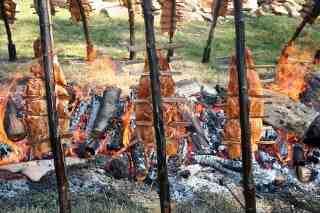
Traditionally, native tribes of the Salishan family of Coastal Indians cut small green saplings, split carefully along most of their length, and used them as holding racks for sides of salmon cut from freshly-caught fish. Cross-braced with strong twigs, the racks were driven into the sand, and the fish were cooked over burning logs.
In the 1930s the small community regularly held a free fish fry/fish bake. In 1931, the fish fry was held at The Bridge Lunch restaurant, the future location of the existing Spouting Horn Restaurant, which was constructed around 1934 after moving The Bridge Lunch building out of the way to a nearby location.
At the 1934 fish fry, Depoe Bay established another one-of-a-kind event – a fish derby. One hundred large sea bass were caught and conditioned for a series of fish races sponsored by the DePoe Bay Pirates, as a means of raising money for a lifesaving station, which was sorely needed. Four hundred people attended the first race. Only a year later, 2,000 people attended the event. A typical race would involve placing cod, bass, or carp in a painted trough, where the fish would race to the gates at the far end, which when hit, released toy balloons denoting the order in which the fish arrived. The fish were free to swim to the open sea after the races.
A 1935 clip from an unknown newspaper describes a race in the style of a sportscast:
The barrier dropped. Salem Cyclone quivered, 400 spectators yelled ‘They’re off!’ and a swirl of water traced the Cyclone’s course down the trough.
Salem Cyclone won by a swim-away. Temperament entered into the Saturday morning fish race, when the Cyclone’s competitors, holding out for a closed course, shop, saltier or not-so-salty water, struck, turned prima donna, quit, sulked, would be-durned-if-they’d-swim.
Promoters were quite disgusted. Pandemonium reigned in the paddock. Trainers of contestants in the next race maintained, however, that their charges would perform.
Into the paddock came the racers. Swish shied at Tiderip; Tiderip swished its tail at Swish; Rasputin sulked at the barrier.
But Rasputin was only foolin’. Up went the barrier on the second race. Rasputin snapped out of his trance – showed his fins to Swish and Tiderip.
There was a race! Rasputin first, Swish second, Tiderip third. All are cod.

A few years later, in October of 1940, a potlatch event called “Indian Summer and Homecoming” was held at Government Point (now Boiler Bay State Park), for Indians of the Northwest. The event was organized by the North Lincoln County Chamber of Commerce, with the cooperation of the Chemawa Indian School and the Siletz Agency. Chief Tommy “Coquille” Thompson of the Siletz Tribes, whose authority was reputed to extend as far as Montana, was a consultant for the event. Chief Thompson and Edgar Simmons of the Grand Ronde Tribes organized their groups and extended invitations to confederations across the state. It was hoped the event would become an annual affair.
About 300 Indians participated. They performed war dances, feather dances, and specialty acts of all kinds in their native attire, and camped on the grounds. There were many Indian articles from the various tribes on exhibition. The oldest Indian dancer at the event was Martha Johnson, who was estimated to be over 100 years old. An Indian-style salmon barbeque was held, with approximately-80-year-old Chemawa Indian Reuben Sanders supervising. Deep-sea boat trips were free to all Indians, courtesy of the local fishermen. Passes were given to Indians at Oceanlake and Taft theatres, and the Otter Crest Outlook house extended courtesies, including the use of its big telescope. The event was considered a “grand success,” and plans began for the next year’s festivities before the month was out.
In 1956, the local Chamber of Commerce sponsored the first annual “Indian Style Salmon Bake.” Residents held a salmon derby prior to the bake. Fish caught in the derby were cooked for the event. Chief Saunders was again in charge of the salmon bake. The fish was cooked for about four hours over a 20-foot log fire near the observatory platform by the Depoe Bay bridge, and 600 persons were served.
In September of 1972, the Salmon Bake was moved from along the seawall of the Depoe Bay State Park to Fogarty Creek State Park to provide more room for serving guests, better parking facilities, and adequate sanitation facilities. Shuttle busses transported people between the city and the park. Volunteers split alder saplings for the racks, and split cedar boards for an 80-foot long fire line, which was constructed on the beach. The dinner of salmon, coleslaw, garlic bread, ice cream, milk, and coffee cost all of $1.75! In 1973, a record 3,200 people attended the event at Fogarty Creek.
Today’s annual salmon bake is held in September in the City Park and is one of the city's biggest events of the year.
